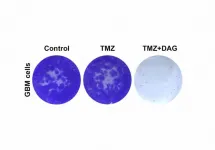The pre-clinical research in human tissue samples, human cell lines and mice could lead to changes in the way that some children with medulloblastoma are treated in the future, if the findings are confirmed in human clinical trials.
Medulloblastoma is the most common high-grade brain tumour in children. Some 70 are diagnosed in the UK each year. Survival rate is 70 per cent for those whose tumour has not spread but it is almost always fatal in cases of recurrent tumour.
The research, published in the high impact journal Nature Communications, looks at inositol hexaphosphate (IP6), a naturally occurring compound present in almost all plants and animals, and showed how it inhibits medulloblastoma and can be combined with chemotherapy to kill tumour cells.
Lead researcher Professor Silvia Marino from the Brain Tumour Research Centre of Excellence at Queen Mary University of London said: "Medulloblastoma occurs in four distinct subgroups (WNT, SHH, G3 and G4). Despite our growing knowledge of the molecular differences between these subgroups, current options are surgery together with radiotherapy and/or chemotherapy for all patients. We desperately need to understand the key molecular events driving tumour growth in each subgroup to design new, less toxic, targeted treatments."
"G4 medulloblastoma is the least understood of all subgroups, despite being the most common and associated with poor prognosis. We have identified a novel way that this type of medulloblastoma is able to adapt its metabolism and grow uncontrollably. Significantly, we have also shown how this energy supply can be blocked. These exciting results bring hope of developing new targeted treatments for patients with this aggressive paediatric brain tumour."
Normal cells are able to switch specific genes on and off as required to control their growth. Known as epigenetics, this process can be disrupted in cancer, leading to over production of specific proteins that contribute to the development and growth of a tumour.
It is already known that epigenetic changes can contribute to the development of medulloblastoma. Furthermore, a protein involved in this process - known as BMI1 - is found in high levels in a broad range of cancers including brain tumours. In medulloblastoma, high levels of it are found in the G4 subgroup, where it sustains tumour growth.
Professor Marino's team has previously demonstrated that, alongside high levels of BMI1, G4 medulloblastoma cells also lack a protein called CHD7. This combination of changes, or signature, is thought to contribute to the development of G4 medulloblastoma.
Now the team has shown that high levels of BMI1 enable the cancer cells to adapt their metabolism and grow aggressively. This change can be reversed by treating the cells with inositol hexaphosphate (IP6). The team also showed that when IP6 was combined with chemotherapy - in this case cisplatin - they observed an increased ability to kill the tumour cells in mice.
Hugh Adams, Head of Stakeholder Relations at Brain Tumour Research said: "These very exciting results reveal a new way for epigenetics to control metabolism within tumour cells. Clinical trials are now required to test the ability of combining IP6 with chemotherapy to treat G4 medulloblastoma, offering promise to a particularly vulnerable group of patients.
"It is great news and brings some much-needed hope for the future. There is still some way to go but we hope that a clinical trial could be up and running in the near future.
"Brain tumours kill more children and adults under the age of 40 yet, historically, just 1% of the national cancer spend has been allocated to this devastating disease. Brain Tumour Research is determined to change this."
Peter Gardiner, from Aston Clinton, near Aylesbury, lost his 13-year-old son to medulloblastoma in November 2017. Next month, May marks six years since his diagnosis.
"I can only describe our experience as a long hell. Firstly, Ollie was diagnosed, then he went through surgery and extensive treatment. When we were told there were no further options for him in the UK, we crowdfunded £500,000 so he could have immunotherapy in Germany. It was our only hope and, sadly, it didn't work," he said.
Ollie's family generously donated £187,000 of the residue of their fundraising to Brain Tumour Research which is funding post-doctoral researcher Sara Badodi who works alongside Prof Marino.
Pete said: "We were overwhelmed by the support of friends, family and strangers who stood by us in our hour of need and came together to help us do the very best we could for our son. It means the world to think that, because of him and the love people showed to us, others might not have to go through what we did."
INFORMATION:
For more information, please contact:
Joel Winston
Communications Manager (School of Medicine and Dentistry)
Queen Mary University of London
j.winston@qmul.ac.uk
Tel: +44 (0)7968 267 064
Notes to Editors
Research paper: 'Inositol treatment inhibits medulloblastoma through suppression of epigenetic-driven metabolic adaptation'. Sara Badodi, Nicola Pomella, Xinyu Zhang, Gabriel Rosser, John Whittingham, Maria Victoria Niklison-Chirou, Yau Mun Lim, Sebastian Brandner, Gillian Morrison, Steve M. Pollard, Christopher D. Bennett, Steven C. Clifford, Andrew Peet, M. Albert Basson and Silvia Marino. Nature Communications. DOI 10.1038/s41467-021-22379-7
Available here after embargo lifts: https://doi.org/10.1038/s41467-021-22379-7
Brain Tumour Research is the only national charity in the UK singularly focused on finding a cure for brain tumours through campaigning for an increase in the national investment into research to £35 million per year, while fundraising to create a sustainable network of brain tumour research centres in the UK.
The £35 million a year funding would bring parity with other cancers such as breast and leukaemia after historically just 1% of the national spend on cancer research has been allocated to brain tumours. This increased commitment would enable the ground-breaking research needed to accelerate the translation from laboratory discoveries into clinical trials and fast-track new therapies for this devastating disease.
Brain Tumour Research is a powerful campaigning organisation and represents the voice of the brain tumour community across the UK. We helped establish and provide the ongoing Secretariat for the All-Party Parliamentary Group for Brain Tumours (APPGBT) which published its report Brain Tumours A cost too much to bear? in 2018. Led by the charity, the report examines the economic and social impacts of a brain tumour diagnosis.
We are also a leading player on the Steering Group for the Tessa Jowell Brain Cancer Mission and we were a key influencer in the Government's 2018 funding announcement, following her death, to commit £40 million over five years. So far, just £9.3 million has been allocated and we continue to work through the APPGBT to hold the Government to account and ensure this money is spent on research into brain tumours.
Key statistics on brain tumours:
Brain tumours are indiscriminate; they can affect anyone at any age
Brain tumours kill more children and adults under the age of 40 than any other cancer
Historically, just 1% of the national spend on cancer research has been allocated to brain tumours
In the UK, 16,000 people each year are diagnosed with a brain tumour
Brain tumours kill more children than leukaemia
Brain tumours kill more men under 70 than prostate cancer
Brain tumours kill more women under 35 than breast cancer
Just 12% of those diagnosed with a brain tumour survive beyond five years compared with an average of 50% across all cancers
Please quote Brain Tumour Research as the source when using this information. Additional facts and statistics are available from our website. We can also provide case studies and research expertise for the media.
About Queen Mary University of London
At Queen Mary University of London, we believe that a diversity of ideas helps us achieve the previously unthinkable.
In 1785, Sir William Blizard established England's first medical school, The London Hospital Medical College, to improve the health of east London's inhabitants. Together with St Bartholomew's Medical College, founded by John Abernethy in 1843 to help those living in the City of London, these two historic institutions are the bedrock of Barts and The London School of Medicine and Dentistry.
Today, Barts and The London continues to uphold this commitment to pioneering medical education and research. Being firmly embedded within our east London community, and with an approach that is driven by the specific health needs of our diverse population, is what makes Barts and The London truly distinctive.
Our local community offer to us a window to the world, ensuring that our ground-breaking research in cancer, cardiovascular and inflammatory diseases, and population health not only dramatically improves the outcomes for patients in London, but also has a far-reaching global impact.
This is just one of the many ways in which Queen Mary is continuing to push the boundaries of teaching, research and clinical practice, and helping us to achieve the previously unthinkable.




